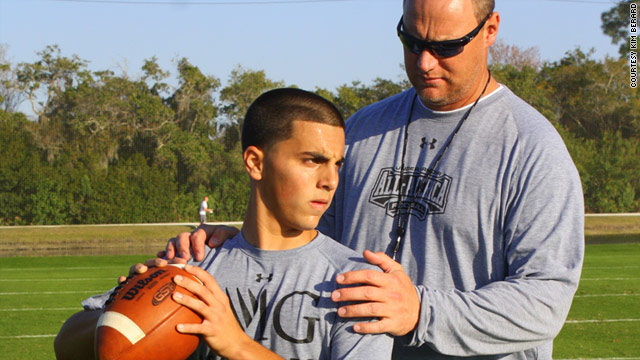With the increasing popularity of youth sports, especially soccer, and the necessity for building more and more athletic fields, many communities are considering constructing synthetic (or artificial turf) athletic fields. Even the Arkansas Razorbacks are considering the move as outlined in a recent article published on January 17, 2009 in the Arkansas Democrat Gazette by Tim Murphy titled “Artificial surface is coach’s desire.” Yesterday’s artificial turf is much different than today’s synthetic in-fill systems in that the new in-fill technology creates a field that looks much more like the real thing (natural grass). The purpose of this turf tip is to provide some additional information regarding synthetic fields so that you’ll be more informed the next time your community is considering a switch from natural grass to artificial.
Maintenance:
It is a myth that synthetic fields require less maintenance than natural turfgrass fields or to say that artificial turf fields are maintenance free. Synthetic fields require 1) additional infill, 2) irrigation because of unacceptably high temperatures on warm-sunny days, 3) chemical disinfectants, 4) sprays to reduce static cling and odors, 5) drainage repair and maintenance, 6) erasing and repainting temporary lines, and 7) removing organic matter accumulation. In a recent presentation by the Michigan State University, Certified Sports Turf Manager, she cited that the typical annual maintenance costs of her artificial turf fields ranged from $13,720-$39,220, while the typical annual maintenance costs of her natural turf fields had a similar range of $8,133-$48,960 (1).
Long-term costs:
Long-term costs are less with natural turf fields compared to synthetic turf fields. Artificial fields need replacing every 8-10 years, whereas a natural turf field does not need as frequent renovation and can be renovated at a much reduced price compared to an artificial field. In a 16-year scenario, Fresenburg came up with an annual average cost for each field type as follows: the natural soil-based field, $33,522; the sand-cap grass field, $49,318; the basic synthetic field, $65,846; and the premium synthetic field, $109,013 (2).
Disposal costs:
When artificial turf (in-fill systems) needs renovating every 8-10 years, there is a hidden cost of disposal. Because the field is filled and top-dressed with a crumb rubber material (typically made from ground automobile tires), the material may require special disposal. Disposal costs are estimated at $130,000 plus transportation and landfill charges (3).
Warranty concern:
Artificial turf (in-fill type) is a relatively new product. As such, its complete life span and maintenance requirements are not fully known. When considering the purchase of one of these systems, the answer to several questions should be researched prior to purchase. These questions include (adapted from Natural Grass and Artificial Turf: Separating Myths and Facts)(3):
Will the artificial turf manufacturing and installation company provide a warranty specifying the expected life of the product?
Will the selling firm provide a warranty bond for the life of the product? This will ensure that there is some legitimate recourse in the event of a product failure even if the seller is no longer in business.
Player preference:
A recent survey of 1,511 active NFL players by the NFL players association found that 73% of the players preferred playing on a natural grass system, while only 18% preferred artificial turf (4). Nine-percent of the players had no preference.
Player injuries:
There is a lack of research comparing injuries incurred on new in-fill artificial fields vs. natural grass fields (5). There are data indicating that the traditional artificial turf fields increased athlete injury, primarily due to increased surface hardness.
Although actual data are not available, anecdotal data are available from NFL players. Players were asked in a 2006 survey “Which surface do you think causes more soreness and fatigue to play on?”. Five-percent felt like natural grass systems increased fatigue, while 74% felt that artificial turf systems were more responsible for fatigue (5). Twenty- one percent felt they were the same. In the open comments section of the survey, the most common comment was “make all fields grass to prevent injuries.”
Potential increases in infections:
An aspect of synthetic turf that is now receiving increased scrutiny is the potential for increased incidences of infections among players that play primarily on in-fill systems. In a report titled “Texas Football Succumbs to Virulent Staph Infection From Turf”, at least 276 football players were reported to be infected with an antibiotic-resistant staph infection, a rate of 517 for each 100,000 individuals (6). The U.S. Centers for Disease Control and Prevention in Atlanta reported a rate for the general population of 32 in 100,000. These infections were primarily associated with increased skin abrasions associated with synthetic turf and the risk of infection that might occur off the field from infections. In-fill systems must now be routinely treated with special disinfectants to reduce the likelihood of infections, adding another cost to the maintenance of these fields.
High temperatures:
Artificial fields cannot be played on all the time due to temperature build-up on warm-sunny days. Artificial field surface temperatures have been documented as high as 199°F on a sunny day with an air temperature of 98°F (7). Researchers at Brigham Young University reported that the surface temperature of a synthetic football field on campus averaged 117°F, with a daily high of 157°F (8). On an adjacent natural grass field the surface temperature averaged 78°F, with a daily high of 89°F. Researchers at Penn State University studied the effect of using irrigation to reduce surface temperatures of synthetic fields and discovered that temperature could be decreased with irrigation, but the effects were short-lived (20 minutes) (9). Because of these high temperatures, an artificial field will remain largely unusable during warm days. Additionally, practicing on an artificial field could increase the incidence of heat stroke, muscle cramping, and overall athlete fatigue. Coaches holding practices on synthetic fields will need to monitor athlete health more closely and will need to limit the duration of practices on these surfaces to reduce the risk of athlete injury.



